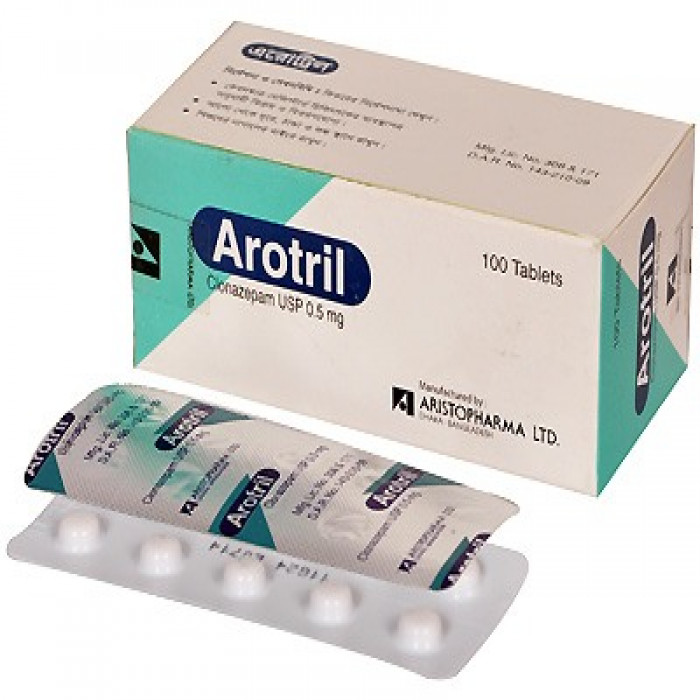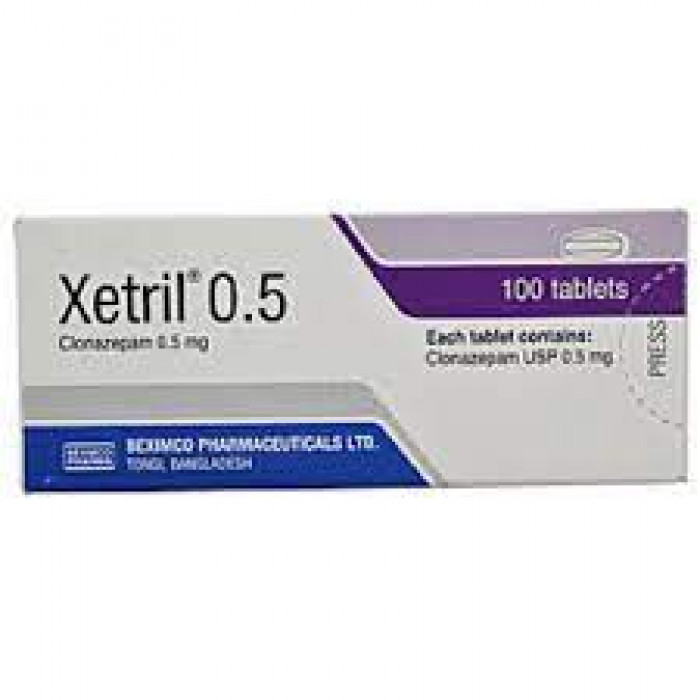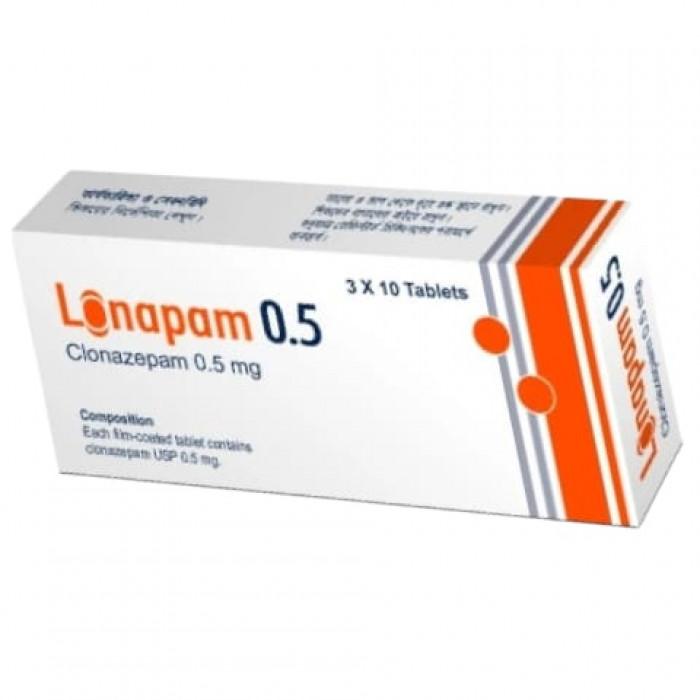
✔ 100% Authentic Product
👁️ Currently Viewing 3184
Tablet Manufacturer/Distributor: Aristopharma Limited Generic Name: Clonazepam .5 mg Tablet
📄Prescription Required
Discount
Price: ৳ 67
MRP:
৳
70
5%
Off

100% Genuine Products, Guaranteed

Safe & Secure Payments, Always

Fast, Secure & Efficient Delivery

Proper Packaging
 Cash on Delivery - All over Bangladesh
Cash on Delivery - All over Bangladesh Regular Delivery - 12-24 Hours, Dhaka City* Charge Tk.39-59
Regular Delivery - 12-24 Hours, Dhaka City* Charge Tk.39-59 Regular Delivery - 24-48 Hours, Other Cities* Charge Tk.99-110
Regular Delivery - 24-48 Hours, Other Cities* Charge Tk.99-110
 ফ্রি ডেলিভারিঃ - ৯৯৯ টাকা+ অর্ডারে, ঢাকা
শহরে
ফ্রি ডেলিভারিঃ - ৯৯৯ টাকা+ অর্ডারে, ঢাকা
শহরে ফ্রি ডেলিভারিঃ - ২৯৯৯ টাকা+ অর্ডারে, ঢাকার
বাহিরে
ফ্রি ডেলিভারিঃ - ২৯৯৯ টাকা+ অর্ডারে, ঢাকার
বাহিরে
100% Genuine Products, Guaranteed
Safe & Secure Payments, Always
Fast, Secure & Efficient Delivery
Proper Packaging
 Cash on Delivery - All over Bangladesh
Cash on Delivery - All over Bangladesh Regular Delivery - 12-24 Hours, Dhaka City* Charge Tk.39-59
Regular Delivery - 12-24 Hours, Dhaka City* Charge Tk.39-59 Regular Delivery - 24-48 Hours, Other Cities* Charge Tk.99-110
Regular Delivery - 24-48 Hours, Other Cities* Charge Tk.99-110 ফ্রি ডেলিভারিঃ - ৯৯৯ টাকা+ অর্ডারে, ঢাকা
শহরে
ফ্রি ডেলিভারিঃ - ৯৯৯ টাকা+ অর্ডারে, ঢাকা
শহরে ফ্রি ডেলিভারিঃ - ২৯৯৯ টাকা+ অর্ডারে, ঢাকার
বাহিরে
ফ্রি ডেলিভারিঃ - ২৯৯৯ টাকা+ অর্ডারে, ঢাকার
বাহিরে
✅ Description:
Clonazepam (Oral) is indicated in:
- Anxiety disorders (Generalized, Phobic & Panic disorders)
- Insomnia and sleep disturbances
- Labile arterial hypertension
- Peri and Postmenopausal anxiety (Anxiety in middle-aged women)
- Burning Mouth Syndrome
- Peri and Postmenopausal anxiety (Anxiety in middle-aged women)
- Postoperative anxiety disorder
- Post-traumatic stress disorder
- Anxiety in cancer patients (palliative treatment)
- Tension Headache
- Restless legs syndrome (RLS) or Wittmaack–Ekbom syndrome
- Nocturnal myoclonus
- Tourette's syndrome
- Bipolar affective disorder
- Resistant depression
- Drug-induced dyskinesia
- Choreiform movement
- Fulgurant pain
- Trigeminal neuralgia
- Epilepsy
It's used to treat panic disorder, both with and without agoraphobia. Panic disorder is defined by the occurrence of unexpected panic attacks, as well as the fear of having further attacks and concern about the implications or consequences of the attacks.
It's also used to treat Lennox-Gastaut Syndrome (petit mal form), akinetic seizures, and myoclonic seizures, either alone or in combination. Patients with absence seizures (petit mal) who have not responded to succinimides may benefit from it.
Clonazepam's effectiveness in long-term use, defined as longer than 9 weeks, has not been well investigated in controlled clinical research. If a physician decides to use Clonazepam for a longer period of time, he or she should reevaluate the drug's long-term effectiveness for the patient on a regular basis.
Pharmacology of Arotril 0.5 Tablet
Clonazepam has benzodiazepine-like pharmacological features, such as anticonvulsive, sedative, muscle relaxing, and anxiolytic actions. Benzodiazepines' central effects are mediated by an increase in GABAergic neurotransmission at inhibitory synapses. Positive allosteric modulation of the GABA receptor for the neurotransmitter is increased in the presence of benzodiazepines, resulting in greater action of released GABA on the postsynaptic transmembrane chloride ion flow.
There is additional evidence of clonazepam's influence on serotonin in animals. Clonazepam suppresses many types of paroxysmal activity, including spike and wave discharge in absence of seizures (petit mal), slow spike-wave, generalized spike-wave, spikes with temporal or other locations, as well as irregular spikes and waves, according to animal data and electroencephalographic investigations in humans. EEG abnormalities in general are repressed more frequently than abnormalities in specific areas. Clonazepam appears to be effective in both widespread and focal epilepsies, according to these data.
Dosage and Administration of Arotril 0.5 Tablet
Oral:
Adults: The initial dose for adults with seizure disorders should not exceed 1.5 mg/day divided into three doses. Dosage may be increased in increments of 0.5 to 1 mg every 3 days until seizures are adequately controlled or until side effects preclude any further increase. Maintenance dosage must be individualized for each patient depending upon response. The maximum recommended daily dose is 20 mg.
The initial dose for adults with panic disorder is 0.25 mg given in two divided doses. An increase to the target dose for most patients of 1 mg/day may be made after 3 days.
Pediatric Patients: In order to minimize drowsiness, the initial dose for infants and children (up to 10 years of age or 30 kg of body weight) should be between 0.01 and 0.03 mg/kg/day but not exceed 0.05 mg/kg/day given in two or three divided doses.
Injection:
Infants and children: half of a vial (0.5 mg) by slow IV injection or by IV infusion.
Adults: 1 vial (1 mg) by slow IV injection or by IV infusion. This dose can be repeated as required (1-4 mg are usually sufficient to reverse the status). In adults, the rate of injection must not exceed 0.25 - 0.5 mg per minute (0.5-1.0 ml of the prepared solution) and a total dose of 10 mg should not be exceeded.
Interaction of Arotril 0.5 Tablet
Phenytoin, carbamazepine, and phenobarbital pharmacokinetics do not appear to be affected by clonazepam. Clonazepam's impact on the metabolism of other medications has not been studied.
Contraindications
It should not be used in patients who have a history of benzodiazepine hypersensitivity, as well as those who have clinical or biochemical signs of substantial liver disease. It can be utilized in people with open angle glaucoma who are on the right medication, but it's not recommended for acute narrow angle glaucoma.
Side Effects of Arotril 0.5 Tablet
Clonazepam's most common adverse effects are depression of the central nervous system (CNS). Drowsiness has been reported in roughly 50 percent of patients treated for seizures, with ataxia occurring in approximately 30 percent. These may improve with time in some situations; behavior issues have been reported in about 25% of patients. Aphonia, coma, tremor, vertigo, disorientation, sadness, amnesia, hallucinations, hysteria, increased libido, sleeplessness, psychosis, and palpitations are some of the symptoms that can arise.
Pregnancy & Lactation
Pregnancy: It is impossible to rule out the possibility of clonazepam causing congenital abnormalities based on preclinical investigations. Anticonvulsant medicines have been shown to be teratogens in epidemiological studies. However, determining which drug or combination of pharmaceuticals is responsible for birth abnormalities from published epidemiological reports is difficult. It's also possible that other factors, like as genetics or the epileptic illness itself, are more important than pharmacological therapy in causing birth abnormalities. The medicine should only be given to pregnant women if the potential benefits outweigh the danger to the fetus in these conditions. Clonazepam should only be used during pregnancy if there is a compelling reason. High doses given during the last trimester of pregnancy or during labor can cause abnormalities in the unborn child's heartbeat and hypothermia. In the neonate, hypotonia, mild respiratory depression, and poor feeding are common. It's important to remember that both pregnancy and abrupt drug withdrawal can cause epilepsy to worsen. Benzodiazepines have been linked to withdrawal symptoms in newborn infants on rare occasions.
Nursing Women: Although Clonazepam's active ingredient has been reported to enter into breast milk in trace amounts, mothers who are taking this medication should not nurse. Breastfeeding should be stopped unless there is a compelling need to use Clonazepam.
Precautions & Warnings
Clonazepam may increase the incidence or hasten the beginning of generalized tonic-clonic seizures in patients who have multiple distinct forms of seizure disorders. This may necessitate the addition of or an increase in the dosage of anticonvulsants. The use of valproic acid and Clonazepam at the same time can cause absent status.
Therapeutic Class
Adjunct anti-epileptic drugs, Benzodiazepine hypnotics
Storage Conditions
Keep in a dry place away from light and heat. Keep out of the reach of children.
⚠️Disclaimer:
At ePharma, we’re committed to providing accurate and accessible health information. However, all content is intended for informational purposes only and should not replace medical advice from a qualified physician. Please consult your healthcare provider for personalized guidance. We aim to support, not substitute, the doctor-patient relationship.










